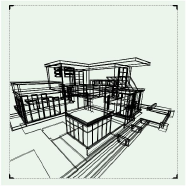Using legacy 2D features
If necessary, you can enable the legacy 2D workflows from versions of Vectorworks prior to 2022. Several settings throughout Vectorworks are related to legacy 2D features, as described below.
Document preferences
Legacy 2D tab: Contains settings that enable the legacy 2D features, specify which plane 2D objects can be created in, and toggle unified view on and off. See Document preferences: Legacy 2D tab.
By default, new files have legacy 2D features disabled; create a template file with the preference enabled, if desired.
Display tab: When legacy 2D features are enabled, the Crop perspective view option is available. This option toggles the rectangular frame around perspective views on and off, switching between a cropped perspective view for presentation and an uncropped perspective view for modeling. In a cropped view, a clipping frame appears around the perspective view window, which is useful for presenting model elevations, for example. Drag the corners to increase or decrease the size of the window.

View bar
When legacy 2D features are enabled, the Screen Plane  and Unified View
and Unified View  options are available, to quickly toggle the settings on and off.
options are available, to quickly toggle the settings on and off.
Saved views
When legacy 2D features are enabled, the Save unified view option is available on the Save View dialog box. This option saves the unified view status with the view. If deselected, the current unified view setting is used when the view is displayed. Additionally, the Unified View option is available on the Redefine Saved View dialog box (Design Suite product required).
Non-unified view
When unified view is disabled, design layers can have different views, lighting options, render modes, and Renderworks backgrounds. When unified view is enabled, the settings you change for the active layer display for all layers, overriding settings for individual layers.
When legacy 2D features are enabled, the Renderworks Background setting is available on the Edit Design Layers dialog box. Select the Renderworks background to use for the selected layer. The background selection is controlled by the render style in effect. If the background choices are not available, set the background in the render style instead.
The Set Spotlight Rendering Options dialog box sets lighting options and a Renderworks background. When unified view is disabled, select Reset lighting options for all layers and Reset Renderworks background for all layers to apply the settings to all layers. When these options are deselected, the lighting options and Renderworks background apply to the active layer only.
Viewports and layer links
When legacy 2D features are enabled, the Project screen objects setting is available on the Create Viewport and Create Detail Viewport dialog boxes, and on the Edit Viewport Style dialog box when Filter by Type is Standard. Select Project screen objects to display 2D objects associated with the screen plane as planar objects.
When legacy 2D features are enabled, the Project screen objects setting is available on the Create Layer Link dialog box. Select Project screen objects to display 2D objects associated with the screen plane as planar objects when the layer link is in a 3D view.
Selecting a 2D object's plane
2D objects can be created as either screen plane objects or layer plane (planar) objects, depending on the selected working plane. 3D objects are, of course, always planar.
The screen plane is coincident to the computer screen, perpendicular to your view direction. 2D objects drawn in the screen plane appear to "float" in 3D views since they remain planar with the screen. For certain legacy workflows, you might create 2D objects in the screen plane.
Planar objects, however, exist relative to 3D space. A planar object is drawn in a 3D plane—either the layer plane or another 3D working plane—and it maintains its geometric relationship to the model when in 3D views.
When legacy 2D features are enabled, the Screen Plane button on the View bar determines whether 2D objects are created as planar or screen plane objects. The available planes depend on the drawing view, the current tool, whether you have saved working planes, and the plane mode setting in the Legacy 2D tab of the Document preferences.
Also, when legacy 2D features are enabled, the Plane setting is available on the Shape tab of the Object Info palette. This allows you to change the planar property of a selected 2D object.
Attaching a sketch to a redline
When legacy 2D features are enabled, one or more selected objects can be attached to a redline object to illustrate the redline comments (Design Suite product required).
In screen plane mode, select the object to be converted. Draw the redline with the Redline tool, and from the Place Redline dialog box, select Attach the current selection as a sketch. The selection is converted to a symbol that is attached to and moves with the redline object. The sketch symbol is placed in a Redline Sketches symbol folder saved with the file. The sketch can be hidden by deselecting Show Sketch from the Object Info palette.